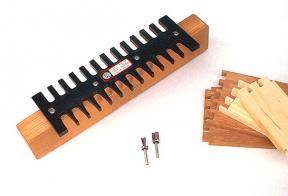Tool basics – router-cut dovetails
Cutting dovetails the new-fashioned way
Dovetails make a beautiful and strong joint. A jig makes it easy to cut these great-looking joints accurately. But do they make sense for your workshop? That depends on how much time you have, how much you value traditional joinery and how comfortable you are using a router.
Dovetail jigs appeal to me because of their speed, and I must not be the only one. Over the past 10 years, the number of jigs on the market has risen to more than a dozen major models, while costs continue to inch down. Some systems are complex and full-featured; others look surprisingly simple but still perform well. Either way, jigs let you incorporate dovetail joints more often than if you cut them by hand. And, depending on the jig, it won’t take much longer to prepare a full set of dovetails than it does matching rabbeted corners. It also takes less skill to produce perfect machine-cut dovetails than it does mediocre handcut ones. But you don’t get something for nothing, and that’s why you have a decision to make.
Router dovetailing is noisier and messier than any other way to join corners. Regardless of the design, all jigs use a similar principle to create interlocking connections on the ends of mating boards. The jig guides the travel of a router bit across wood, creating triangular pins and wedge-shaped tails. You’ll find some jigs designed to make dovetails that are visible on only one side of a corner (half-blind dovetails), while others produce a joint that’s visible on both sides of a corner (through dovetails). Some jigs do both. If you’re interested in creating the most authentic joint, consider a through-dovetail jig that also allows you to determine the spacing of pins and tails.
Besides the jig, you also need a decent router-at least a 10-amp model and, ideally, one with a 1/2″ collet. True wood is essential too. Although it’s not absolutely necessary to own a jointer and thickness planer to prepare boards for machine dovetailing, it will definitely boost joint accuracy if you do.
Cutting dovetails with a jig also involves one universal hazard: tear-out. Wherever a router bit exits wood, it almost always leaves behind chipped corners that will ruin the appearance of your dovetails. The design of some jigs allows you to clamp sacrificial backer boards to protect your workpiece. This is an important feature.
You can also eliminate tearout using a technique called climb-
cutting. On the initial router pass across the visible face of a board, carefully move the router in the same direction as bit rotation instead of the more typical opposite-to-rotation approach. Taking a shallow 1/16″- to 1/8″-deep initial climbcut virtually eliminates tearout. Just hold firmly onto the router, as it will want to jump ahead under the power of its own spinning bit.
Despite the drawbacks, dovetail jigs are worth it in my book. But there is one nagging thing-they do such a good job so very quickly that it all seems a little dishonest, doesn’t it? But it’s a deceit that’s just too hard for me to resist.
Jump to a section
- Page 1 : Cutting dovetails accurately
- Page 2 : Jigs available on the market
To leave a comment, please log in












No comments